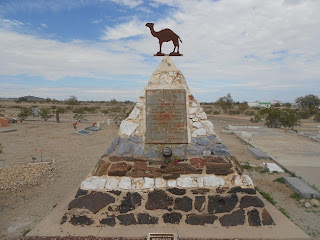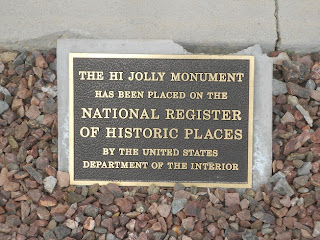 |
| Former home of Hi Jolly, Quartzsite AZ |
Western Trips visited the interesting town of Quartzsite Arizona, about eighteen miles east of the Colorado River off of Interstate 10.
The history of Quartzsite includes it's use as a stopping off and gathering place for pioneers heading to the California gold fields. The site was also established as a stage stop on the site of old Fort Tyson in 1866. Mining for gold, lead and mercury were also active industries in Quartzsite's past.
Today, the town of Quartzsite is a very popular gathering place for those winter travelers we refer to as "snowbirds" wishing to escape the harsh northern winter weather.
The Quartzsite Annual Gem and Mineral Show
The town of Quartzsite is an interesting stop for a variety of reasons. First of all, Quartzsite hosts a two month long gem and mineral show each year which brings visitors there from around the U.S. It's a popular swap and meet held during both January and February. The gem and mineral show will see over a million visitors and over one thousand exhibitors. There's good reason that this show is held in Quartzsite since the town has the nickname as the "Rock Capital of the World". In addition to this Quartzsite is known for its RV and ATV friendly atmosphere. Quartzsite is known to many as a rock hound's paradise. Vendors of rocks, minerals, fossils and gems create one of the world's largest outdoor flea markets.
The Annual Hi Jolly Daze and ATV Parade
When you visit Quartzsite Arizona you have to know about the historic significance of a man named Hi Jolly.
In the 1850's the U.S. Government had the U.S. Cavalry import seventy-seven camels to the U.S. from Syria. Along with the camels came their Syrian camel driver and caretaker, Hadji Ali. The American's referred to him as Hi Jolly.
The U.S. camel experiment was meant to determine the feasibility of employing camels in the southwest desert region to transport both passengers and freight. At the time Jefferson Davis who was Secretary of War under President Franklin Pierce found the Army needed to improve transportation in the southwestern US, which he and most observers thought a great desert. The idea of using camels had been around for some time but Davis was unable to test the project until he became a cabinet secretary.
The camel experiment actually worked out quite well. Survey teams headed west from around San Antonio and traveled through the Big Bend region of Texas and some made their way westward to California. Compared to horses, the animals appeared more sure footed in the desert environment and could go without water much longer than a horse. Some camels eventually made their way to the old Benicia Arsenel in the San Francisco Bay area.
 |
| Monument dedicated to Hi Jolly and the Camel Corp |
When war broke out the camel experiment took a back seat and was essentially forgotten. The camels were either auctioned off or set free in the deserts of Arizona and California. The camel experiments in the southwest American desert region remain one of the military's most interesting ventures.
As a result of the abandoning of the camels, Hi Jolly, the animal's caretaker, was out of a job. He was discharged from the Quartermaster Department of the U.S. Army in 1870. He tried his hand with the freight business with the few camels he had left. About fifteen years later he found employment by the army as a packer during General Crook's military campaign against Geronimo. Hi Jolly did stay in the U.S. through the remainder of his life and passed away in 1902 in Quartzsite Arizona.
A monument was dedicated to Hi Jolly in 1935 and was placed in the Quartzsite Cemetery. The monument shown in this article at Hi Jolly's grave is in the shape of a pyramid built from local stones and has a bronze camel at the top.
Quartzsite Arizona, A Mecca for Winter Travelers
The population of Quartzsite Arizona grows enormously during the winter months of January and February. In addition to the people arriving there for the annual gem and mineral shows, the winter weather in Quartzsite is warm and dry.
Tourism is the key to Quartzsite's economy and the town is extremely popular for RV camping. RVs by the thousands camp in relatively primitive desert conditions very economically. The area around Quarzsite is surrounded by several mountain ranges and you'll find a unique collection of flora and fauna. There are also a good number of ancient petroglyphs in the area.
For a list of RV parks around Quartzsite see the website www..quartzsitebusinesschamber.com/camp.htm
Links to two additional Western Trips photo articles you'll enjoy include;
A Hiking Trip at California's Joshua Tree National Park
A Visit to Old Scottsdale Arizona
See These Carson City Nevada Historic Sites
Things to See and Do in La Jolla California
A good website for additional information and an event calendar for Quartzsite is www.quartzsitemuseum.com. You'll also find a current list of planned field trips. The Quartzsite Historical Society is a non-profit organization dedicated to the support and management of the Tyson’s Well Stage Station Museum.The Quartzsite Museum is located at 161 W. Main Street.
Quartzsite Arizona is located about 129 miles west of Phoenix along Interstate 10 and about 119 miles east of Indio California in the greater Palm Springs area.
(Photos from author's private collection)
View Larger Map



